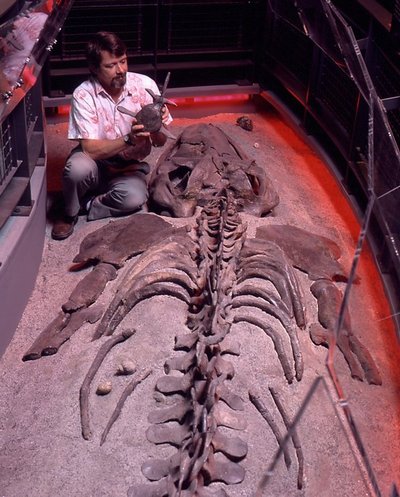August 31, 1998
Museum displays earliest known fossil of a toothless whale
The world’s oldest known fossil of a toothless whale, a previously unknown genus and species, has yielded clues about the evolution of the ocean-going giants. Now, after five years of study and preparation, it is on public display at the Burke Museum of Natural History and Culture at the University of Washington.
The bones are in considerably better order now than when they were discovered on July 31, 1993, in a quarry on the Olympic Peninsula between Port Angeles and Clallam Bay. Bruce Crowley, the museum’s fossil preparator, used small tools – including a jackhammer and sandblasting tool that fit in the palm of the hand – to carefully peel away the covering of silty sandstone, called “concretion” because it had become as hard as concrete. Much of the work was done in a museum gallery where the public could watch Crowley’s progress.
When amateur fossil hunters found the bones, they were in a haphazard arrangement and many were broken. Crowley put them in order and repaired damaged pieces. Then he reconstructed missing parts by using bones on the opposite side of the body as models. Only a few tail bones and flipper bones have not been reconstructed. That’s because there was nothing on which to model them and, because it is a unique specimen, Crowley said he didn’t want to guess.
He estimates the mammal was 15 to 18 feet long, about the size of a modern pygmy right whale, which weighs from 3¼ to 4½ tons and is among the smallest of the baleen whales. (Click here to see a drawing by Crowley of what the whale probably looked like.)
Not only is the fossil the only one of its kind, nothing similar is nearly as complete. Most often, little more than whale skulls or isolated individual bones are found, Crowley said.
The fossil was discovered about 80 feet above the Strait of Juan de Fuca, where it was unearthed by bulldozers at a quarry operated by Holnam Co., whose workers helped museum geologists extract the bones. The quarry was on the sea floor 28 million years ago, during the Oligocene period, when the whale lived.
“That little time, the Oligocene, is a very important time in whale evolution and we have so little material from then,” Crowley said. “It’s a very critical time in which the evolution of whales was happening very quickly.”
Unlike whale fossils that pre-date it, this whale had no teeth. Instead, like modern humpback and gray whales, it was equipped with structures called baleen, fringed plates made of a material similar to human fingernails. Baleen whales use the fringes to sift food from the ocean.
The blowhole on the fossil whale is far forward on the snout, instead of near the top of the head where it is found on modern whales. Some features, such as the angle of attachment of rib bones to vertebrae and the length of arm bones, retain structural aspects found in land mammals but which have changed substantially in whale fossils from later periods, Crowley said. There also are differences in skull bones.
Crowley plans to publish a scientific paper about the fossil, at which time names will be given to the genus and species.
Meanwhile, he is working at the museum on extracting another whale fossil from its concretion, and he has identified three other whale fossil locations on the Olympic Peninsula.
###

